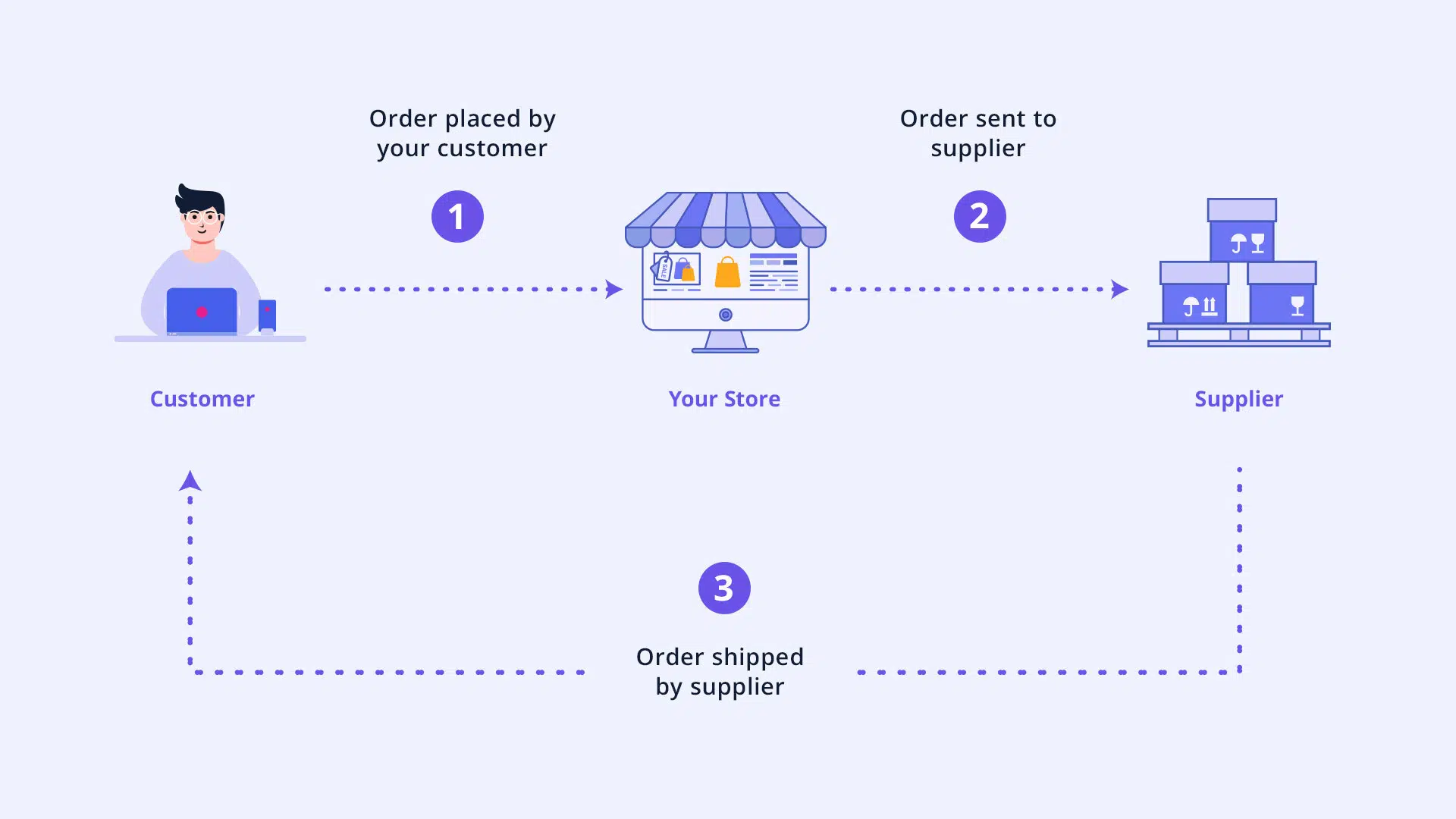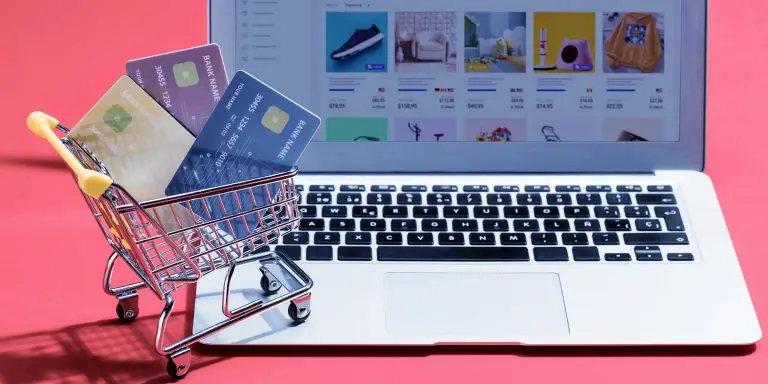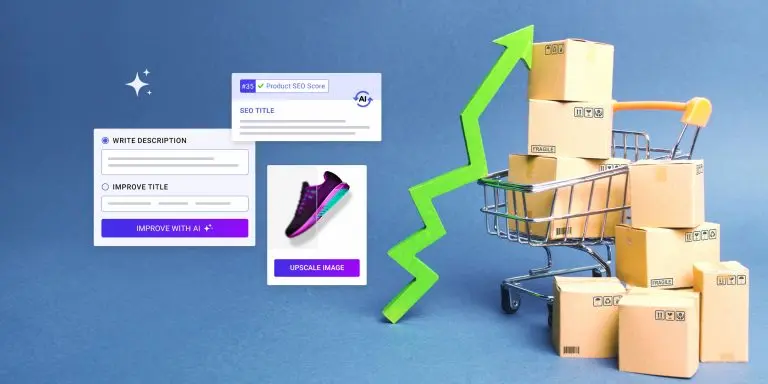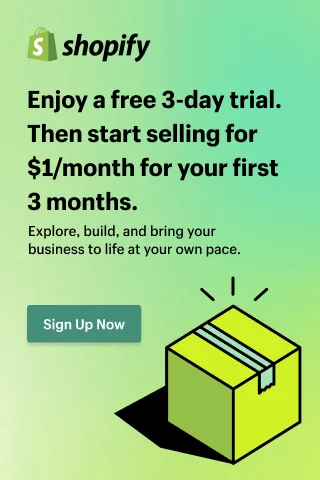In the world of ecommerce, these next business models, both allowing you to sell products without ever holding or managing inventory, are probably the most popular: dropshipping and print on demand (POD). Both offer low-cost ways to start an online store without needing to hold stock, but they come with their own unique advantages, disadvantages, and potential profitability.
If you’re thinking about starting an online business but can’t decide between these models, this guide will help you understand the key differences and how they impact your business’s bottom line.
Table of Contents
What is dropshipping?
Dropshipping is an ecommerce business model where the seller doesn’t keep products in stock. Instead, when a customer places an order, the seller buys the item from a third-party supplier, who then ships it directly to the customer. You act as the middleman, handling the marketing, customer service, and sales, while the supplier takes care of manufacturing, inventory, and logistics.

This is how dropshipping works:
- A customer places an order on your online store.
- You forward the order to a dropshipping supplier. Or if you work with AppScenic, the order is forwarded automatically to a supplier.
- The supplier ships the product directly to the customer.
- You keep the difference between the price you charge the customer and the supplier’s price.
You can start a dropshipping business by following these seven main steps:
- Choose the right dropshipping product
- Find a dropshipping supplier
- Set up an online dropshipping store
- Brand your business
- Set up the legal and financial infrastructure
- Market your dropshipping business
And yes, dropshipping is still worth it, read this article for more insights about the profitability of this business model.
What is print on demand (POD)?
Print on demand is a form of dropshipping, but with a twist. Instead of selling ready-made products, you sell custom-designed items. You create a design and upload it to a POD platform like Printful or Printify. You don’t handle the inventory or printing process, but you do have control over the product’s appearance.
This is how print on demand works:
- A customer places an order on your online store for a customized product, such as a T-shirt, mug, or phone case.
- You forward the order to a print on demand supplier.
- The supplier prints the design on the product.
- The supplier ships the printed product directly to the customer on your behalf.
- You keep the difference between the price you charge the customer and the supplier’s cost for production and fulfillment.
These are the main steps to follow to start a print on demand business:
- Choose a platform, such as Printify, Printful, or Gelato that integrates with your online store.
- Create your own designs or hire a designer to produce designs for your store.
- Set up your store; just like dropshipping, use platforms like Shopify or WooCommerce to display and sell your products.
- Promote your designs by using social media, influencer marketing, or email marketing and showcase your unique designs.
Pros and cons of dropshipping
Pros of dropshipping
Low startup costs
One of the biggest advantages of dropshipping is that it requires minimal upfront investment. You don’t need to purchase inventory in advance, which eliminates the risk of buying stock that doesn’t sell.
No inventory management
With dropshipping, you never have to worry about storing, packaging, or shipping products. Your supplier handles all of these logistics, freeing up your time to focus on growing your business.
Wide product range
Since you don’t have to pre-purchase products, you can easily offer a wide variety of items to your customers. From tech gadgets to home decor, the possibilities are endless. You can also test different products and niches without risking large sums of money.
Scalability
Dropshipping is highly scalable because your supplier handles the bulk of the work. Whether you sell 10 or 1,000 items per month, you don’t have to worry about fulfilling orders, making it easier to grow your business quickly.
Cons of dropshipping
Lower profit margins
While dropshipping is easy to get started with, the profit margins are often lower compared to traditional retail. Because you’re paying a premium to the supplier for handling fulfillment, you have less control over pricing and may need to sell at higher volumes to see significant profits. Here’s how much an average dropshipping store can make.
Lack of control over shipping and quality
Since your supplier handles fulfillment, you rely on them to ship products on time and ensure quality control. This lack of oversight can result in longer shipping times and lower product quality, which can hurt your brand’s reputation.
High competition
Dropshipping has a low barrier to entry, making it a highly competitive field. Many dropshipping businesses end up selling the same products, making it harder to differentiate yourself and build a loyal customer base. That’s why the best way to start dropshipping is by finding and selling an ever-green niche.
Pros and cons of print on demand (POD)
Pros of print on demand
Creative control
One of the biggest draws of POD is the ability to customize products with your own designs. This means you can create unique, branded merchandise that appeals to your target audience, allowing you to stand out in the crowded ecommerce space.
No inventory or printing hassles
Like dropshipping, POD eliminates the need to manage inventory or worry about fulfillment. Your POD supplier prints the product only when an order is placed, and they handle shipping directly to the customer.
Flexibility and variety
POD allows you to offer a wide range of products, from clothing and accessories to home decor and digital prints. You can experiment with different designs and products without upfront costs, making it easy to pivot your business if needed.
Higher profit potential on custom items
Since you’re selling unique products that feature your own designs, you can often charge higher prices than with standard dropshipping products. Customers are more likely to pay a premium for something personalized or creative.
Cons of print on demand
Longer fulfillment times
Print on demand can take longer to fulfill than traditional dropshipping because each item is printed to order. This can lead to slower delivery times, which may deter some customers from purchasing, especially those expecting fast shipping.
Limited product customization
While you have control over the design, you’re limited by the products and printing techniques your POD supplier offers. For example, you may not have access to certain types of apparel or advanced customization options like embroidery or special printing techniques.
Niche focus required
POD businesses often thrive in specific niches where customers are looking for custom, creative designs. If you don’t have a strong grasp of your target audience or struggle to produce appealing designs, it may be challenging to achieve profitability.
Profitability comparison: dropshipping vs. print on demand
Profit margins
Dropshipping
Typically, dropshipping offers lower profit margins due to higher supplier fees and intense competition. However, if you can scale your store effectively and offer trending products, you can still achieve decent profitability. The key is to focus on selling at higher volumes to offset lower per-sale margins.
Print on demand
While POD can have higher product costs due to the customization factor, you can often charge more for unique, personalized products. This allows for better profit margins, particularly if your designs resonate with your audience.
However, because of higher production costs, volume matters less, and quality design matters more.
Customer appeal
Dropshipping
Dropshipping is ideal if you want to offer a wide range of products without focusing too much on branding. It’s best suited for those who prefer not to worry about product design or customization but are skilled at finding trending products and marketing them effectively.
Print on demand
POD is best for creatives who want to build a brand around their unique designs. This business model works well for niche markets where customers are willing to pay more for something exclusive or personalized.
Scaling potential
Dropshipping
Dropshipping is highly scalable. Since you’re not handling fulfillment or inventory, it’s relatively easy to add new products and markets. The main challenge is maintaining quality control and customer satisfaction as you scale.
Print on demand
Scaling a POD business may require more effort, as each sale is linked to a custom design. However, once you have a few winning designs, you can sell the same products repeatedly without much extra effort.
Which model is right for you?
When deciding between dropshipping and print on demand, consider your strengths, interests, and long-term goals.
If you’re more interested in selling a broad range of products, dropshipping may be the better option. It allows you to experiment with different niches, sell at scale, and focus primarily on marketing and customer acquisition. Check out the 15 most successful Shopify dropshipping stores and learn the secrets behind their success.
On the other hand, if you’re a creative individual who wants to offer something unique and build a brand around your designs, print on demand could be the perfect fit. While it may require more effort upfront in terms of design, it offers higher profit potential on each sale.
Conclusion
Both dropshipping and print on demand are profitable business models for starting an online store without ever managing inventory. Dropshipping’s strength lies in its scalability and variety of products, while POD shines in its creative flexibility and branding potential.
Your choice will depend on your goals, interests, and the type of customer experience you want to offer. Whichever path you choose, both models offer a low-risk, high-reward way to dive into the world of ecommerce.












